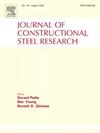Experimental and numerical investigations on trip steel pipe buckling restrained brace
IF 4
2区 工程技术
Q1 CONSTRUCTION & BUILDING TECHNOLOGY
引用次数: 0
Abstract
Buckling-Restrained Brace (BRB) is commonly used as an energy-dissipation damper in building structures as it has the characteristic of yielding without buckling. In this paper, a novel all-steel triple pipe buckling restrained brace was proposed. The Triple Steel Pipe Buckling Restrained Brace (TSP-BRB), as an all-steel type of buckling restrained brace, is mainly composed of axial force pipe (TP1), supporting pipe (TP2), inner/outer restrained pipes (TP3/4) and connecting sections by welding. Compared with traditional buckling restrained brace, TSP-BRB can provide favorable hysteresis performance, as well as light-weight and easy prefabrication. In order to investigate the energy dissipation effect of TSP-BRB, two different TSP-BRB specimens with different outer pipe diameter-thickness ratios were designed and quasi-static cyclic experiments were carried out in this study. The results show that the TSP-BRB has a full hysteresis curve since the axial force pipe TP1 can develop higher-mode deformation to dissipate energy. Meanwhile, in order to investigate the energy dissipation mechanism and deformation characteristics of TSP-BRB, this paper conducted detailed research on the axial force pipe TP1, and gave the circumferential deformation of the axial force pipe under different stress states. Besides, this paper investigated the effect of gap width and opening size of axial force pipe TP1 on the energy dissipation performance and stress distribution of TSP-BRB by using the finite element analysis software Abaqus. The main contribution of this study is to analyze the energy consumption mechanism of TSP-BRB in detail by means of experimental and numerical analysis methods and give the suggested values of related parameters, which can provide a reference for the development of TSP-BRB.
求助全文
约1分钟内获得全文
求助全文
来源期刊

Journal of Constructional Steel Research
工程技术-工程:土木
CiteScore
7.90
自引率
19.50%
发文量
550
审稿时长
46 days
期刊介绍:
The Journal of Constructional Steel Research provides an international forum for the presentation and discussion of the latest developments in structural steel research and their applications. It is aimed not only at researchers but also at those likely to be most affected by research results, i.e. designers and fabricators. Original papers of a high standard dealing with all aspects of steel research including theoretical and experimental research on elements, assemblages, connection and material properties are considered for publication.
 求助内容:
求助内容: 应助结果提醒方式:
应助结果提醒方式:


